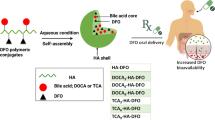Abstract
Mono-antennary galacto derivatives of cholesterol are being actively developed to direct lipoplexes to the asialoglycoprotein receptor (ASGP-R) on hepatocytes. Here we report on a novel ASGP-R ligand cholest-5-en-3-yl [1-(β-d-galactopyranosyl)-1H-1,2,3-triazol-4-yl]methylcarbamate (4), assembled by a copper(I)-catalyzed azide-alkyne cycloaddition (click chemistry), and compare it with cholest-5-en-3-yl-β-d-galactopyranoside (2) and cholest-5-en-3-yl [1-(β-d-galactopyranosyl-1′-oxy)phen-4-yl]carbamate (3), in liposome formulations with or without 5 mol% distearoylphosphatidylethanolamine poly(ethylene glycol)2000, intended for DNA delivery to ASGP-R-positive hepatocyte-derived HepG2 cells and the ASGP-R-negative embryo kidney cell line HEK293. Transfection levels attained with lipoplex 4 were 100 and 300 % greater than those for lipoplexes 2 and 3 respectively in HepG2 cells, while competition assays reduced transfection levels by up to 98 %. Transfection activities achieved in HEK293 cells were up to three orders of magnitude lower. Therefore, 4 is representative of a new class of promising hepatotropic ligands for gene delivery.





Similar content being viewed by others
References
Barenholz Y (2001) Liposome application: problems and prospects. Curr Opin Colloid Interface Sci 6:66–77
Dorasamy S, Narainpersad N, Singh M, Ariatti M (2012) Novel targeted liposomes deliver siRNA to hepatocellular carcinoma cells in vitro. Chem Biol Drug Des 80:647–656
Dos Santos N, Allen C, Doppen AM, Anantha M, Cox KAK, Gallagher RC, Karlsson G, Edwards K, Kenner G, Samuels L, Webb MS, Bally MB (2007) Influence of poly(ethylene glycol) grafting density and polymer length on liposomes: relating plasma circulation lifetimes to protein binding. Biochim Biophys Acta 1768:1367–1377
Egelhaaf SU, Werhli E, Müller M, Adrian M, Schurtenberger P (1996) Determination of size distribution of lecithin liposomes: a comparative study using freeze fracture, cryoelectron microscopy and dynamic light scattering. J Microsc 184:214–228
Filion MC, Phillips NC (1997) Toxicity and immunomodulatory activity of liposomal vectors formulated with cationic lipids toward immune effector cells. Biochim Biophys Acta 1329:345–356
Higuchi Y, Kawakami S, Fumoto S, Yamashita F, Hashida M (2006) Effect of the particle size of galactosylated lipoplex on hepatocyte-selective gene transfection after intraportal administration. Biol Pharm Bull 29:1521–1523
Johnsson M, Edwards K (2003) Liposomes, disks, and spherical micelles: aggregate structure in mixtures of gel phase phosphatidylcholines and poly(ethylene glycol)-phospholipids. Biophys J 85:3839–3847
Moore NW, Kuhl TL (2006) Bimodal polymer mushrooms: compressive forces and specificity towards receptor surfaces. Langmuir 22:8485–8491
Narainpersad N, Singh M, Ariatti M (2012) Novel neoglycolipid: formulation into PEGylated cationic liposomes and targeting of DNA lipoplexes to the hepatocyte-derived cell line HepG2. Nucleosides Nucleotides Nucleic Acids 31:206–223
Parkin DM, Bray F, Ferley J, Pisani P (2005) Global Cancer Statistics, 2002. CA Cancer J Clin 55:74–108
Pathak A, Vyas SP, Gupta KC (2008) Nano-vectors for efficient liver specific gene transfer. Int J Nanomed 3:31–49
Percot A, Briane D, Coudert R, Reynier P, Bouchemal N, Lievre N, Hantz E, Salzmann JL, Cao A (2004) A hydroxyethylated cholesterol-based cationic lipid for DNA delivery: effect of conditioning. Int J Pharm 278:143–163
Romøren K, Thu BJ, Bols NC, Evenson Ø (2004) Transfection efficiency and cytotoxicity of cationic liposomes in salmoid cell lines of hepatocyte and macrophage origin. Biochim Biophys Acta 1663:127–134
Shigeta K, Kawakami S, Higuchi Y, Okuda T, Yagi H, Yamashita F, Hashida M (2007) Novel histidine-conjugated galactosylated cationic liposomes for efficient hepatocyte-selective gene transfer in human hepatoma HepG2 cells. J Control Release 118:262–270
Singh M, Ariatti M (2003) Targeted gene delivery into HepG2 cells using complexes containing DNA, cationized asialoorosomucoid and activated cationic liposomes. J Control Release 92:383–394
Singh M, Rogers CB, Ariatti M (2007) Targeting of glycosylated lipoplexes in HepG2 cells: anomeric and C-4 epimeric preference of the asialoglycoprotein receptor. S Afr J Sci 103:204–210
Acknowledgments
This study was supported by the National Research Foundation (NRF), Pretoria, the University of the Witwatersrand (University and Science Faculty Research Councils) and Stellenbosch University (Faculty and Departmental funding), South Africa. RUI thanks the University of the Witwatersrand Research Office and the NRF for a postdoctoral fellowship. The authors also gratefully acknowledge Mr R. Mampa (University of the Witwatersrand) and Mr D. Jagjivan (University of KwaZulu-Natal) for the NMR spectroscopy service. Ms J. Schneider and Ms M. Ismail (Mass Spectroscopy Service, University of Dortmund and Max Planck Institute for Molecular Physiology, Dortmund, Germany) and Dr James Wesley-Smith (Electron Microscopy, Westville campus University of KwaZulu-Natal) are also acknowledged.
Supporting information
Online resource 1: Spectral data.
Online resource 2: Plasmid amplification.
Supplementary Fig. 1 Cryo-TEM micrographs of unPEGylated (a) and PEGylated (b) liposomes and unPEGylated (c) and PEGylated (d) lipoplexes prepared at endpoint ratios.
Supplementary Fig. 2 Cell viability assays on HepG2 and HEK293 cells were conducted under transfection conditions.
Author information
Authors and Affiliations
Corresponding author
Electronic supplementary material
Below is the link to the electronic supplementary material.
Rights and permissions
About this article
Cite this article
Govender, D., Islam, R.U., De Koning, C.B. et al. Stealth lipoplex decorated with triazole-tethered galactosyl moieties: a strong hepatotropic gene vector. Biotechnol Lett 37, 567–575 (2015). https://doi.org/10.1007/s10529-014-1729-5
Received:
Accepted:
Published:
Issue Date:
DOI: https://doi.org/10.1007/s10529-014-1729-5




